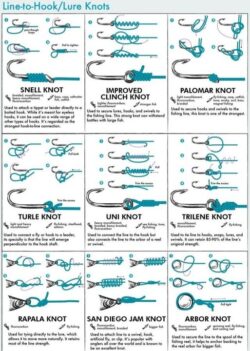Fishing knots are critical to fishing success. Different knots are required for certain line types, gear, and presentations. Not all Knots are created equally.
For most of my fishing, I tie a proper Clinch Knot. “8 wraps and one more for good luck”, was how my dad taught me. This knot is exceptionally versatile and strong.
For line-to-line connections I use a Blood Knot. This knot takes practice but is the strongest way to connect 2 different diameter lines together.
All knots will weaken your monofilament line. If you tie the knot correctly, with the right number of wraps, a lick at the end, and a smooth snug up, the knot will be around 85% of the original line strength.
Some knots add action to your lures. The Rapala Knot acts like a split ring to give your lure more movement and action. Uni Knots are a great choice when using braided lines. The Arbor Knot is the best way to attach line to a reel’s spool. The Uni Knot will also hold the line onto a spool correctly.
Snell Knots are perfect for masking bottom rigs that will hold cut bait. A Turle Knot will make a perfect inline connection between the hook shank and line. Every knot has a purpose.
The Palomar Knot is a strong knot that is not commonly used. It takes a bit longer to tie but is very strong. While you are dealing with the knot, don’t forget to sharpen your hooks.
Tying a proper knot requires clear vision. Use cheaters if you must. Licking your fingers will help you control thinner lines. It is also a good idea to practice tying knots using heavy or thicker lines or cord. You can feel what you need to do when tying a knot. Keep a knot card in your tackle box or vest to remind you how to tie other knots that you rarely use.
A strong Knot will help you land a Strong fish!
Montana Grant